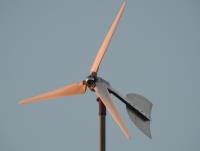 Add My Company
Add My Company

Many of us are trying harder to ‘do our bit’ when it comes to reducing our carbon footprint, so generating our own electricity to use in our homes is becoming far more commonplace. The number of solar panels we see on rooftops around the country grows daily. Wind turbines are still a less common sight in a residential setting, but as the more efficient option and with energy prices soaring they too are seeing a surge in popularity. However, there are numerous designs and styles of residential use wind turbines on the market so how do you know which one is the most efficient choice for you? In this article, we will look at the different types of wind turbine design and wind turbine blade design and which is more efficient, in what circumstances and why. We’ll be keeping it simple, short and sweet so you have all the information you need if you are considering buying a wind turbine to cut your energy bills and reduce your carbon footprint at the same time, all without the jargon. Let’s get started… Types Of Wind Turbines When thinking about what wind turbine design is the most efficient, there are two main types of design that we need to consider. These are vertical-axis wind turbines and horizontal-axis wind turbines. Vertical Axis Turbines These types of wind turbines have their blades parallel to the ground. This means they are less dependent on consistent wind direction and they require less wind to work. However, they are less efficient as they do not utilise as much of the wind’s power. Horizontal Axis Turbines These are the most common type of wind turbines. We see these in use on wind farms, both on land and off-shore. A horizontal-axis wind generator has blades that are perpendicular to the ground. They are more efficient in that they can utilise more wind power. That being said, to maximise efficiency they must be facing the wind unless a YAW system is installed which can rotate according to wind direction. For smaller wind turbines, such as those for residential or individual use, there is the possibility of blades being damaged by strong winds. To prevent damage, it is recommended that a tail furling system is used to turn the blades out of winds that are too intense. Wind Turbine Blade Design Flat Blade Turbines Traditionally, wind turbines such as windmills used flat blades to harness the wind’s power. It is easy to see why this design has been in use for millennia and is still used by many wind turbine DIYers; they are easy to construct, easy to fix and require little to no technical or design knowledge. However, flat blades also create drag meaning that they are not enormously efficient. Curved Blade Turbines More recent wind turbine design uses an aerofoil style. This means it has a curved top which enables the wind to move around it. This harnesses aerodynamic forces which create lift and therefore spin the turbine faster. Curved blades are consequently far more efficient. Which Is The Best Turbine Design For Efficiency? Although there are other factors to consider regarding space and position when thinking about efficiency and turbine design, the best type is a curved blade, horizontal axis wind turbine. To browse our selection of wind turbines, head to our sales page or if you have further questions, don’t hesitate to get in touch with us here at Generator Pro.
For more information on What Wind Turbine Design Is The Most Efficient? talk to Generator-Pro

